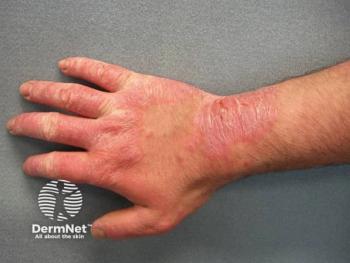
- Dermatology Times, April 2025 (Vol. 46. No. 04)
- Volume 46
- Issue 04
Championing Patient and Consumer Safety in Dermatology
Key Takeaways
- The AAD meeting highlighted patient safety concerns, including benzoyl peroxide recalls due to benzene contamination and corticosteroid misuse.
- FDA recalls of BPO products underscore the importance of regulatory compliance and product safety in dermatology.
Dermatology Times' Editor in Chief Christopher Bunick, MD, PhD, discusses patient safety in the wake of AAD 2025, focusing on BPO recalls, corticosteroid risks, and JAK inhibitor innovations.
Another American Academy of Dermatology (AAD) meeting is in the books. For those dermatologists who descended upon Orlando, Florida, in March 2025, they experienced a jam-packed meeting; it was full of fun, education, and networking, and ultimately provided a lot of walking/exercise.
One theme permeating the meeting was patient safety. Whether it was questions over benzoyl peroxide (BPO) products and benzene, the misuse of topical and oral corticosteroids, or the continued desire to better understand biologics and Janus kinase (JAK) inhibitor safety, it was clear that dermatologists highly regard patient safety. During and shortly after the AAD meeting, the first BPO product recalls occurred due to elevated benzene levels; therefore, I thought it worth examining each of these safety topics in this month’s letter.
I had the privilege of speaking as part of the panel “Personal Care Product Safety: The BPO Controversy and Beyond” during the Dermatology Innovation Forum, sponsored by Advancing Innovation in Dermatology. Alongside my fellow panelists, we explored product safety from regulatory, manufacturing, dermatologic, and health risk perspectives. A key focus of the discussion was the distinction between regulatory and manufacturing violations—such as a product failing to maintain stability through its expiration date—and the actual health risks a contaminant may pose to consumers. This distinction is critical, as it prevents manufacturers from dismissing regulatory violations under the pretext that no proven health risks exist.
What happened with BPO? Since last year’s AAD in San Diego, the FDA has been quietly working on evaluating BPO products and validating prior research that showed many BPO products have elevated levels of benzene, a well-established carcinogen, higher than the conditional/emergency regulatory limit of 2 ppm set forth by the FDA (the goal is 0 benzene).1-2
On the heels of this year’s AAD, the FDA announced voluntary recalls of several BPO products that the FDA verified had excessive levels of benzene. This recall (1) validates the original research identifying some BPO products are unstable and form benzene, (2) indicates some products can form benzene levels that violate FDA regulations, and (3) demonstrates to manufacturers, clinicians, and patients/consumers that the FDA will take action to protect public safety. When it comes to over-the-counter or prescription skin care products, cosmetics, or medicines, it is the dermatology community that must lead by example and champion high-quality, safe, and tested products for our patients and skin care consumers. To ensure and improve product/drug quality, particularly with regard to purity and safe ingredients, dermatology should embrace independent quality control testing, demand more manufacturer testing and transparency, and accept and recommend only the highest-quality products for our patients. It is also important to remember that generic is not always better, nor is “all natural.”
The safety risks associated with chronic topical and oral corticosteroid use have long been a challenge in dermatology. Excessive use of topical corticosteroids can lead to skin atrophy, telangiectasias, hypopigmentation, increased infection risk, and striae, while even short-term systemic corticosteroid use carries significant safety concerns. Despite these risks, dermatology providers have traditionally relied on steroids due to their rapid onset of action and deep treatment response. However, research into new signaling pathways and innovation of multiple nonsteroidal therapeutics has revolutionized the nonsteroidal topical and oral toolbox available to treat inflammatory skin diseases.
Topically, we traditionally have used vitamin D analogues, calcineurin inhibitors, and a moderate-potency phosphodiesterase 4 (PDE4) inhibitor (crisaborole). Now, we have a highly potent topical PDE4 inhibitor (roflumilast),3 an aryl hydrocarbon receptor agonist (tapinarof), and topical JAK inhibitors (ruxolitinib, and soon-to-be delgocitinib). These topical nonsteroidal medications close the gap with steroids with respect to the magnitude of anti-inflammatory response and speed of onset; in fact, a head-to-head trial of a topical JAK inhibitor vs triamcinolone favored the JAK inhibitor.4 Increased incorporation of advanced nonsteroidal topicals into regular clinical practice will help skirt excessive steroid use, reduce the risk of steroid adverse effects,5 and enhance patient safety.
Despite the wide availability of advanced systemic therapies, including oral JAK inhibitors and biologics, dermatology clinicians continue to prescribe oral corticosteroids for long-term use. A recent study found that approximately 20% of patients with moderate to severe atopic dermatitis received oral corticosteroids between March 2017 and March 2024, with about 32% of these patients using them for more than 1 month, and in some cases, 3 months or longer. This prolonged use of systemic corticosteroids does not align with the AAD guidelines,6 which recommend against their long-term use due to significant safety concerns.7 Moreover, systemic corticosteroids have a worse safety profile than other systemic therapies.8 Given the availability of FDA-approved, safe, and effective oral JAK inhibitor options like upadacitinib—which provides rapid itch relief and skin clearance—systemic corticosteroids should be limited to short-term use (< 30 days) as a bridging therapy when necessary and avoided as maintenance treatment. This approach prioritizes patient safety and reduces the risk of steroid-induced adverse events.
Oral JAK inhibitors continue to demonstrate strong and reassuring safety profiles in atopic dermatitis (upadacitinib, abrocitinib) and alopecia areata (baricitinib, ritlecitinib, deuruxolitinib), with long-term safety data for upadacitinib extending up to 6 years of exposure in atopic dermatitis,9 and established long-term safety profile across 5 other indications. Given that dermatologists routinely prescribe more than 50 medications carrying boxed warnings,10 the favorable and growing body of safety evidence for JAK inhibitors supports their broader adoption in clinical practice. Especially encouraging are the rates of major adverse cardiovascular events, venous thromboembolism, and malignancy being within or below the baseline rates in patients with atopic dermatitis not receiving JAK inhibitors. Also, they are lower than the adverse event rates for systemic corticosteroids and traditional immunosuppressive agents, which makes a strong argument that advanced systemic therapies like JAK inhibitors enhance patient safety.
Whether a dermatology provider adopts a “do no harm” or “treat every patient like your own family member” philosophy, we all have at the center of our being a strong desire for patient safety. Safety comes in many sizes and shapes—quality control, minimizing chemical contaminants, product stability, low adverse events—but at the root of the concern over safety is the genuine desire to help people heal and live healthy lives. Dermatology is ripe with innovation, and our community should stand strong together to continue to champion products, therapies, and procedures that augment patient safety along with efficacy.
Christopher Bunick, MD, PhD, is an associate professor of dermatology and physician-scientist at the Yale School of Medicine in New Haven, Connecticut.
References
- Kucera K, Zenzola N, Hudspeth A, et al. Benzoyl peroxide drug products form benzene. Environ Health Perspect. 2024;132(3):37702. doi:10.1289/EHP13984
- Kucera K, Zenzola N, Hudspeth A, et al. Evaluation of benzene presence and formation in benzoyl peroxide drug products. J Invest Dermatol. Published online October 7, 2024. doi:10.1016/j.jid.2024.09.009
- Wang J, Ho M, Bunick CG. Chemical, biochemical, and structural similarities and differences of dermatological cAMP phosphodiesterase-IV inhibitors. J Invest Dermatol. Published online November 27, 2024. doi:10.1016/j.jid.2024.10.597
- Kim BS, Howell MD, Sun K, et al. Treatment of atopic dermatitis with ruxolitinib cream (JAK1/JAK2 inhibitor) or triamcinolone cream. J Allergy Clin Immunol. 2020;145(2):572-582. doi:10.1016/j.jaci.2019.08.042
- DiRuggiero D, DiRuggiero M. Beyond skin deep: the systemic impact of topical corticosteroids in dermatology. J Clin Aesthet Dermatol. 2025;18(1–2 suppl 1):S16–S20
- Bunick CG. Utilization and duration of systemic corticosteroid exposure in atopic dermatitis patients after the introduction of advanced therapies. Presented at: Fall Clinical Dermatology Conference 2024; October 24-27, 2024; Las Vegas, NV.
- Davis DMR, Drucker AM, Alikhan A, et al. Guidelines of care for the management of atopic dermatitis in adults with phototherapy and systemic therapies. J Am Acad Dermatol. 2024;90(2):e43-e56. doi:10.1016/j.jaad.2023.08.102
- Daniele S, Bunick C. JAK inhibitor safety compared to traditional systemic immunosuppressive therapies. J Drugs Dermatol. 2022;21(12):1298-1303. doi:10.36849/JDD.7187
- Bunick C, Silverberg JI, Chovatiya R, et al. Long-term upadacitinib safety in moderate-to-severe atopic dermatitis up to 6 years: an integrated analysis with over 9000 patient-years of exposure. Presented at: Revolutionizing Atopic Dermatitis Virtual Conference; December 8, 2024.
- Winterfield L, Vleugels RA, Park KK. The value of the black box warning in dermatology. J Drugs Dermatol. 2015;14(7):660-666.
Articles in this issue
8 months ago
Dermatology Times April 2025 Print Recap8 months ago
Expert Insights From AAD 20258 months ago
How to Best Support Women With Menopausal AcneNewsletter
Like what you’re reading? Subscribe to Dermatology Times for weekly updates on therapies, innovations, and real-world practice tips.



















